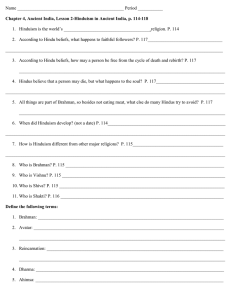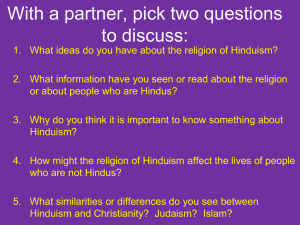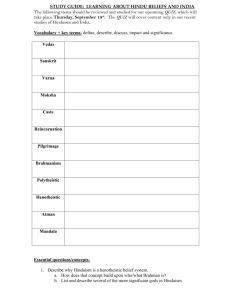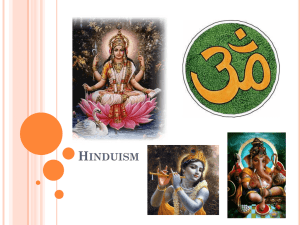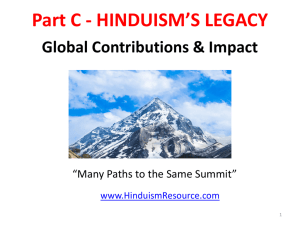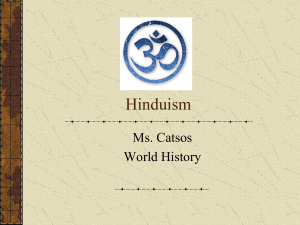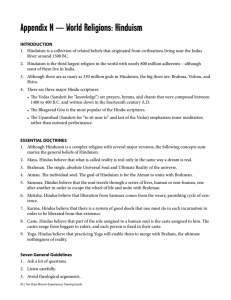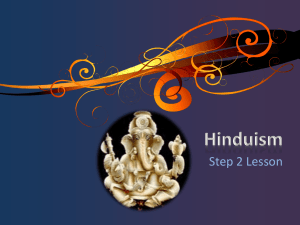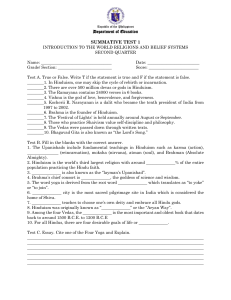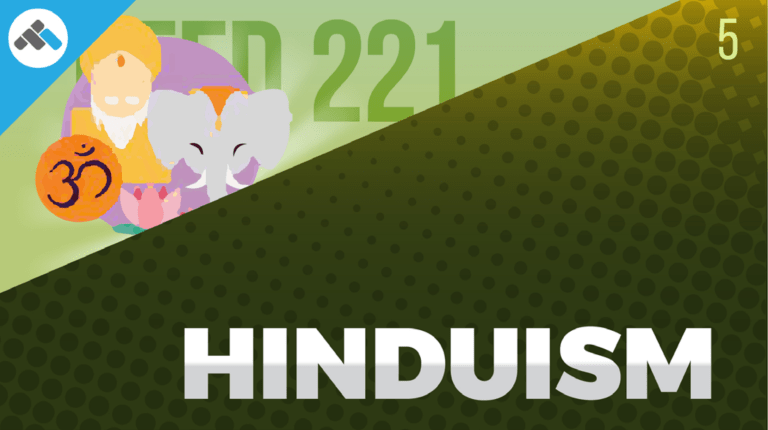
Click header below to go directly to page 5.1 ORIGIN 5.2 THEISTIC BELIEF 5.2.1 Belief in Brahman 5.2.2 The Trimutri 5.3 IMPORTANT CONCEPTS IN BUDDHISM 5.3.1 Dharma 5.3.2 Karma 5.3.3 Avatar 5.3.4 Reincarnation 5.3.5 Moksha 5.3.6 Puja and Hindu Worship 5 5.4 SACRED SCRIPTURES 5.4.1 Shruti 5.4.2 The Four Vedas 5.4.3 Smriti 5.5 HINDU CREATION STORY 5.6 HINDU CUSTOM 5.6.1 Holy Days 5.6.2 Holy Places 5.7 CASTE SYSTEM 5.8 RELIGIONS RELATED TO HINDUISM HINDUISM 5. Hinduism 5.1 ORIGIN ▶ Most scholars believe Hinduism started somewhere between 2300 B.C. and 1500 B.C. in the Indus Valley, near modern-day Pakistan. But many Hindus argue that their faith is timeless and has always existed. It is not known who founded Hinduism nor is there a consensus on when it was established. Unlike other religions, Hinduism has no one founder but is instead a fusion of various beliefs. Hinduism is now simply described as the product of spiritual, religious, and social practices of the people from a large portion of South Asia, with 1.2 billion followers living in countries of India, Pakistan, Bangladesh, and Nepal. The period when the Vedas were composed became known as the “Vedic Period” and lasted from about 1500 B.C. to 500 B.C. Rituals, such as sacrifices and chanting, were common in the Vedic Period. The Epic, Puranic and Classic Periods took place between 500 B.C. and 500 A.D. Hindus began to emphasize the worship of deities, especially Vishnu, Shiva and Devi. The term Hindu and Hinduism were not coined by Hindus themselves. The Greeks associated the name Hindu with those people living beyond the Sindhu (or Indus) River. During that time, Hindus were identified merely in the geographical sense. It was in the 19th century when the terms Hindu and Hinduism began to be used in their religious sense. It also currently refers to a set of cultural practices observed by communities who follow this religion. One practice is the caste system in India, where people are subject to social stratification based on their ethnicity and social class. ▶ Click to view YouTube 5. Hinduism 5.2 THEISTIC BELIEF ▶ 5.2.1 BELIEF IN BRAHMAN Brahman is regarded as the Supreme Being in Hinduism. Brahman is regarded by Hindu as a unifying existence and the ultimate divine reality. According to Hinduism, Brahman is manifested in everything in the universe and in the consciousness of all. Since Brahman is exists in everything and everyone, there is oneness and interconnectedness in all entities in the universe. This omnipresence of Brahman also gives rise to the Hindu practice of ahimsa or non-violence and respect for all life forms, including plants and non-human animals. The soul, referred to as the atman, is also seen as a representation of Brahman. The atman is seen as an eternal and universal entity. 5.2.2 THE TRIMURTI Aside from their belief in Brahman as the Supreme Being, Hindu also worship other gods who are considered representations of Brahman. They seek the help of their gods and goddesses in times of need. There are numerous deities in Hinduism, also known as devas (gods) and devis (goddesses). These terms both mean “divine” and “radiant.” Of these gods, three are regarded as the ▶ Click to view YouTube 5. Hinduism most important; they are known as the Trimurti. They possess powers that complement one another, and are important in order for the universe to function properly. These gods are also accompanied by goddesses acting as their consorts. Brahma is the Hindu god of creation. He is believed to have created the universe and everything that it contains. His consort is Sarasvati, the goddess of knowledge. Shiva is the Hindu god of destruction. This destruction power is seen not just as a transition to death, but ultimately to rebirth or a new form of life. It is also deemed necessary as a way of destroying evil forces and restoring order in the universe. Parvati is the consort of Shiva, and is regarded as a benevolent goddess. Vishnu is the Hindu god credited with the power to sustain or preserve the universe. His consort is Lakshmi, who is considered the Hindu goddess of wealth and prosperity. 5.3 IMPORTANT CONCEPTS IN HINDUISM 5.3.1 DHARMA ▶ Hinduism is sometimes referred to as sanatana dharma, which translates to “eternal law.” This law applies to all Hindus regardless of their classification in the caste system, and transcends time and local practices of the religion. Dharma refers to the religious and moral laws governing all people’s action and lives. ▶ Click to view YouTube 5. Hinduism The dharma instructs Hindus to follow a path of righteousness, proper conduct, morality, and justice. This is then related to the Hindu belief in Brahman, as the dharma also guides Hindus in ensuring that all living beings are treated with kindness and respect. 5.3.2 KARMA In Hinduism, Karma is the law of cause and effect. According to karma, every action has a corresponding consequence. This consequence will be experienced either in this current life or future lives. 5.3.3 AVATAR The avatar is an incarnation of a Hindu deity on earth in various forms, including animals and human beings. Avatars have appeared throughout time in order to ensure that humans do not ultimately succumb to evil forces. These avatars also exist in order to restore cosmic order. 5.3.4 REINCARNATION ▶ Reincarnation is the Hindu phenomenon of the atman’s immortality. Through reincarnation, the atman will repeatedly undergo birth and rebirth until it finally attains liberation. ▶ Click to view YouTube 5. Hinduism 5.3.5 MOKSHA Moksha can be regarded as the end of the cycle of birth and rebirth also known as samsara. It is the stage in life where one has already attained the ultimate liberation of the soul. 5.3.6 PUJA AND HINDU WORSHIP Puja is the central act of Hindu worship. It is a ritual where the devotee connects and communicates with the Hindu deity. The ritual involves meditation and the offering of food and flowers to Brahman and the other Hindu deities and may be performed either at home or in a temple. Hindus believe that performing the puja enables them to gain strength from the deities. In general, Hindus also believe that rituals and meditation help tame an individual’s unnecessary desires in life, and aid in developing spiritual discipline. Without this, according to Hindus, one may easily give in to allure of worldliness. 5.4 SACRED SCRIPTURES The ancient scriptures of Hinduism are classified into two: Shruti (that which is heard or revealed) and Smriti (that which is remembered). These ancient texts are written in Sanskrit (ancient Indo-European language of India). ▶ Click to view YouTube 5. Hinduism 5.4.1 SHRUTI The Vedas are classified as the shruti texts in Hinduism and are regarded as the foundation of the religion. It is also often considered the earliest source of India’s religious history. The Vedas, from the Sanskrit word meaning “Knowledge,” contain spiritual teachings encompassing all aspects of life. These spiritual teachings are regarded as eternal and universal truths. They were composed approximately between 1500 and 600 BCE by the ancient Indo-European seers or prophets. This period is also known as the Vedic period. The term “Vedas” is the origin of the word “Vedic,” which is used to refer to one earliest forms of Indian religion. Also known as Vedism, this religion was practiced by the Indo-Europeans from Iran who came to India at about 1500 BCE. Followers of the Vedic religion believed in many gods as well as some goddesses. They also sacrificed animals as a way of worshipping these deities. It is believed that rishis (seers) and sages received the Vedas from divine revelation. They are the further said to have received the Vedas through intuition, meditation, and introspection. These seers and sages then acted as the divine instruments in preserving and transmitting the revealed divine knowledge. It took many centuries of oral transmission before the Vedas were written down in Sanskrit. Throughout that time, sages refined and expanded the teachings of the vedas. ▶ Click to view YouTube 5. Hinduism 5.4.2 THE FOUR VEDAS The Vedas are composed of four books or collections. Each of these collections contains hymns, prayers, ritual text, meditation, reflections, and philosophical speculations. The Rig Veda or “knowledge of the verses” is the oldest of the four vedas and is also considered the most important. The Rig Veda consists of 1,028 hymns containing praises to gods, as well as songs and prayers associating divine deities with natural forces. The hymns were composed around 1500 to 1200 BCE. They were used in rituals, and were finally written down after they were transmitted orally for generations. Priestly families were the keepers of the Vedas during that time. The Yajur Veda or the “knowledge of the Sacrifice” contains instructions on how to conduct Hindu rituals. These rituals often involve performing sacrifices, and Hindu priests use the Yajur Veda in leading these ceremonies. The Sama Veda or the “Knowledge of Song” contains verses which are mostly from the Rig Veda. The Sama Veda teaches the manner in which chants must be performed in sacrificial rites. This is important for Hindus, as they believe that reciting prayers and chanting a sacred text aloud is the best way for its words to be instilled in their minds. The Atharva Veda or “Knowledge of the Fire Priest” is a later addition to the Vedas. It is considered different from the other three Vedas as its material does not necessarily pertain to the praise of gods or sacrificial rituals. Instead, the Atharva Veda contains spells and incarnations for healing different illnesses and casting away evil spirits. ▶ Click to view YouTube 5. Hinduism 5.4.3 SMRITI The smriti texts, or “that which is remembered,” constitute the other major category of texts in Hinduism, and are believed to enrich the teachings provided by the shruti texts. The Upanishads are sometimes classified as smriti texts. However, some of the Hindu texts that are more widely considered as smriti are the Puranas and the Indian epics Ramayana and Mahabharata, which are dated as early as the Vedic period. The latter contains the Bhagavad Gita, which is believed to tackle some of the important values that Hindus practice. 5.5 HINDU CREATION STORY ▶ Aside from rituals, chants, stories, and philosophical musings, the sacred text of Hinduism also provide various accounts of the origin of the universe. According to Hindus, these creation myths all share truths that validate their faith and beliefs. Hindus believe that the different metaphors in these myths convey elements of philosophical and spiritual truth. For Hindus, these stories help them understand the purpose of creating different forms of life in the universe, and how each of these life forms are interconnected. One of the Hindu creation stories is found in the Rig Veda. This story tells of how the offering of the body parts of a mythical giant named Purusha led to the creation of the universe. It is also believed that this offering brought about the establishment of the caste system in Hindu society. In other story another story from the Vedic texts, Prajapati (or the “lord of creatures”) was said to have sacrificed himself so that the creation of the world will be accomplished. ▶ Click to view YouTube 5. Hinduism The Chandogya Upanishad in the Sama Veda provides another account of the creation of the universe. In the story, the universe is believed to have come from a golden embryo or egg. It later cracked open, revealing a silver and a golden part. The sun also came from the egg, together with other animate beings. The sun is considered a representation of the Brahman in the story. In these creation stories, the origin of the universe is often rooted in the process of sacrifice. By offering sacrifices, karma is generated, and this paves the way for rebirth after death. This explains why sacrifice is considered a fundamental aspect of Hindu tradition up to the present. This is especially evident in the Hindu practice of making offerings. Hindus make offerings to the deities for the favors and blessings they granted. They also pay homage and make offerings to their ancestors to whom they owe their lives, and to their departed loved ones who had shared their lives here on earth. 5.6 HINDU CUSTOM 5.6.1 HOLY DAYS Hindu festivals are often a way of worshipping and giving tribute to their numerous deities. One of the most well-known among these festivals is the Diwali, which is celebrated for five days in October or November. It is clebrated by lighting earthenware lamps in temples and houses as a way of welcoming Lakshmi. ▶ Click to view YouTube 5. Hinduism Another Widely celebrated festival among the Hindus is the Janmashtami, which takes place in August or September, as the commemoration of the birth of Krishna who is regarded as the avatar of Vishnu. It begins by a day-long fasting until midnight, generally believed to be the hour of Krishna’s birth. The Navratri, meanwhile, is a festival celebrated for nine days in September or October. One of the most important ceremonies of this festival is the Kanya Puja, where nine girls are represented as nine forms of Durga, the “mother goddess.” 5.6.2 HOLY PLACES Like in other religions, certain places and structure holds significance to the Hindu faith. The mandir or Hindu temple is the most commonly known among these sacred places in Hinduism. In the Hindu temples, worshippers perform religious ceremonies and practices such as the puja and the study of the Vedas. These temples are said to help man connect to the Hindu divinities. Aside from the mandir, the other place that Hindus hold with high regard is the Ganges River in northern India. They believe that bathing in the Ganges purifies an individual spiritually. The Ganges is also said to be personified as a goddess named Ganga Devi. ▶ Click to view YouTube 5. Hinduism 5.7 CASTE SYSTEM One of the major issues that Hindus deal with is rooted in the caste system. In the caste system, Hindu society is divided into four groups referred to as varnas. This classification traces itself back to the period when the Vedas were being composed, and the Aryans comprised the majority of the population of the ancient northern India. The Brahmins constitute the highest class in the caste system. Its members include priests and the scholars and teachers of Hinduism. Kshatriyas are traditionally ranked after the Brahmins, and are made up of the society’s warriors and rulers. Vaishyas is traditionally composed of traders and merchants, and the economy of the ancient Hindu depended on them. And the Shudras constitute the lowest class in the system. The Shudras class is composed of the laborers, commoners, peasants, and servants. There are also people in Hindu society who are not members of any of the four classes. They are known as the Untouchables, also referred to as the Dalit. It is believed that a Hindu becomes untouchable due to his or her failure to pursue his or her dharma in his or her past life, thus resulting in bad karma. ▶ Click to view YouTube 5. Hinduism 5.8 RELIGIONS RELATED TO HINDUISM Jainism and Sikhism are two other religions that developed during the ancient times in India. These two religions are practiced by a significant number of people around the world, and they bear a number of similarities with Hinduism in their doctrines. Jainism originated in eastern India in the 7th to 5th century BCE. Its name is derived from the Sanskrit verb ji, which means “to conquer.” Jains, the followers of Jainism, are expected to “conquer” or overcome worldly desires in order to achieve enlightenment and omniscience. Like Hinduism, Jainism places importance on reincarnation and the attainment of good karma. Sikhism, meanwhile, emerged in the Punjab region in India. The name of the religion is derived from the Punjabi word sikh, meaning “disciple” or “learner.” Unlike Hindus, Sikhs believe in only one god, Waheguru, and do not worship icons; they also reject the caste system. Similar to Hindus, however, they also believe that a degree of divinity exists in everyone; they also value oneness and selflessness in their doctrine. ▶ Click to view YouTube that’s the end of lesson 5! We can call it a day for now! Only when you are finished reviewing the lesson SEVERAL TIMES, CLICK THIS GOOGLE FORM ICON Must be accomplished before our synchronous session
